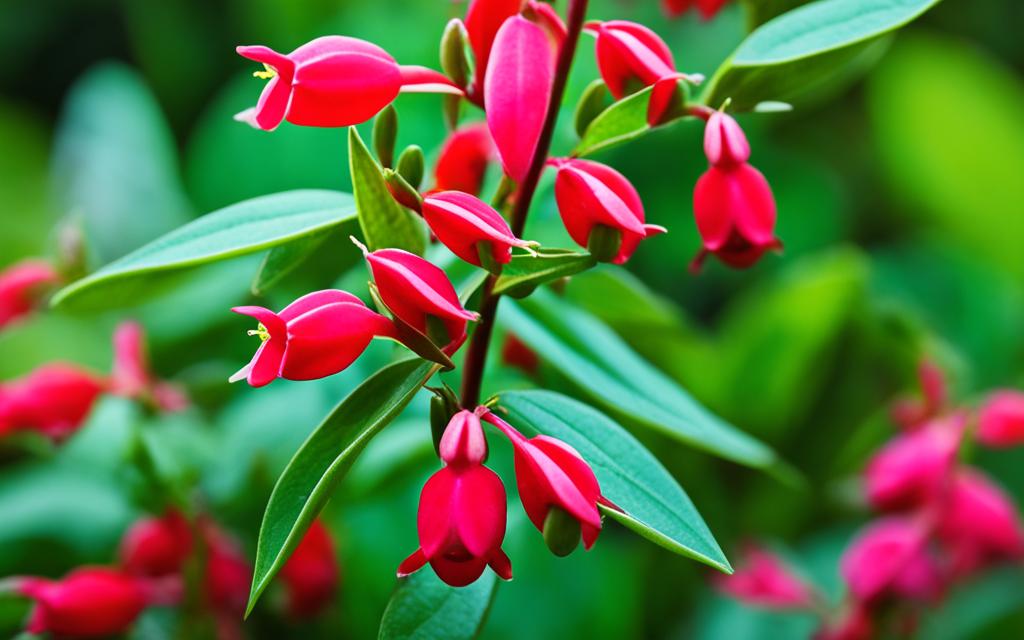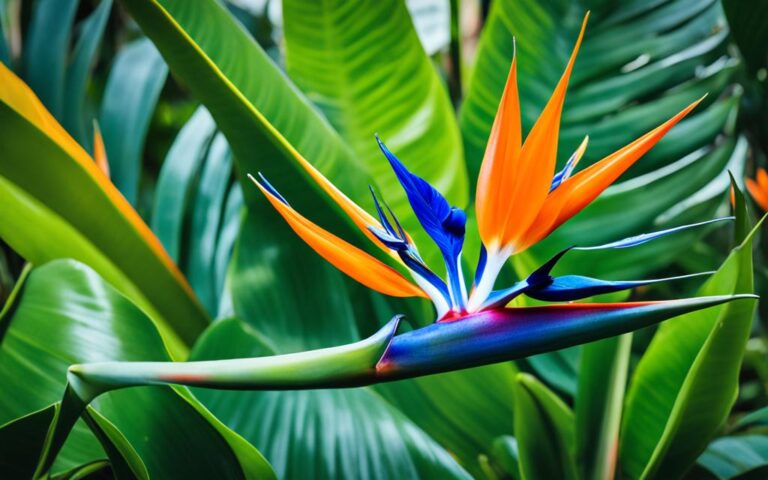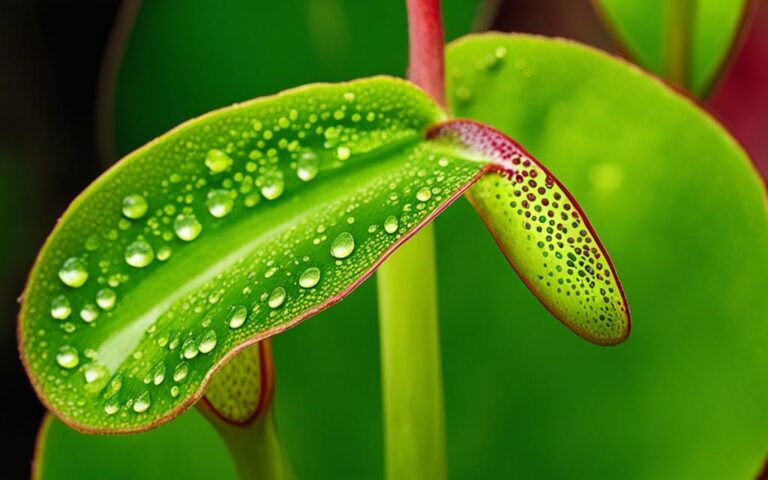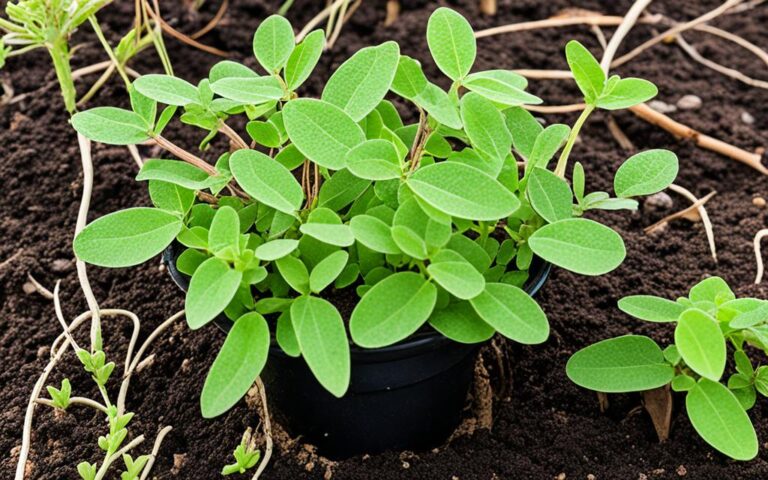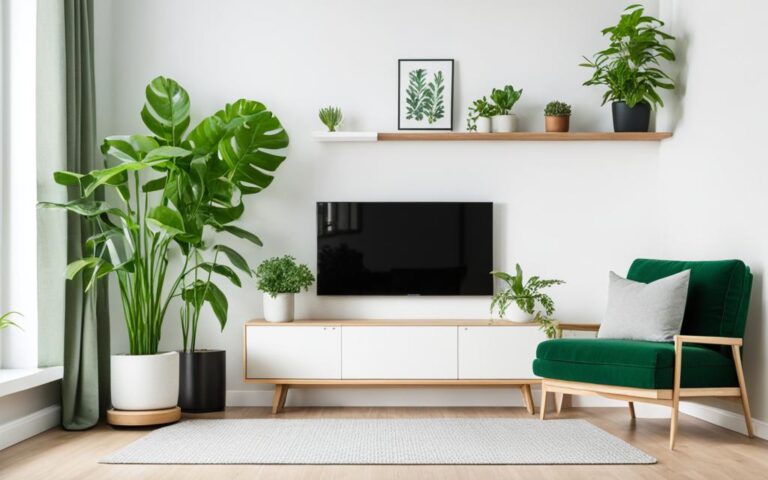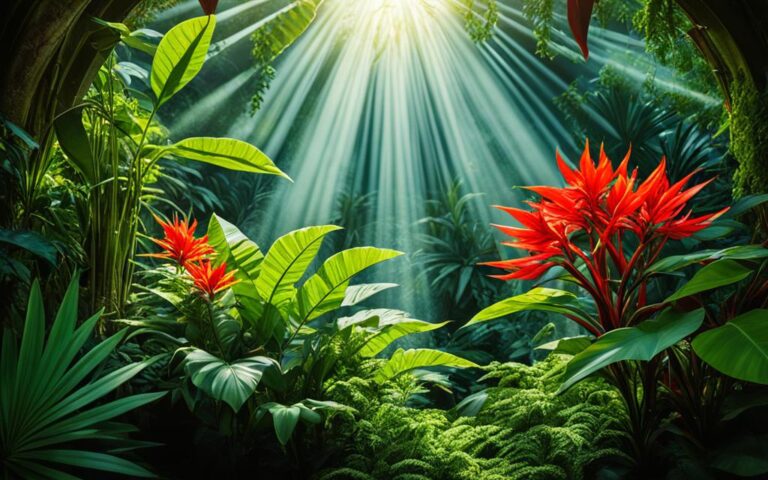Lipstick Plant: Care Guide for This Exotic Beauty
Did you know the Lipstick Plant (Aeschynanthus radicans) comes from Southeast Asia and thrives indoors? It’s a tropical epiphytic plant known for its vibrant red flowers that look like lipstick. The plant has dark green leaves and grows in a cascading way, making it a beautiful houseplant.
Key Takeaways
- The Lipstick Plant is a tropical epiphytic houseplant with unique “lipstick-like” red flowers.
- It thrives in warm temperatures between 75-85°F and can tolerate down to 60°F, but growth slows at lower temps.
- Lipstick Plants prefer bright, indirect light and should be fertilized regularly during the growing season.
- Well-draining, nutrient-rich soil is essential for optimal growth and blooming.
- Proper watering, pruning, and pest management are key to maintaining a healthy Lipstick Plant.
Introduction to the Lipstick Plant
What is a Lipstick Plant?
The Aeschynanthus, also known as the Lipstick Plant, is a beautiful tropical houseplant. It brings a touch of exotic beauty to any room. Its flowers look like lipstick, making it a popular choice for indoor gardens.
Origin and Habitat
This plant comes from the tropical areas of Southeast Asia. It grows on other plants and gets moisture and nutrients from its environment. Indoors, it needs a potting mix that drains well to do well.
There are about 185 types of Lipstick Plants. Some popular ones in the UK include Aeschynanthus radicans, Aeschynanthus pulcher, Aeschynanthus marmoratus, Aeschynanthus speciosus, and Aeschynanthus japhrolepis.
| Cultivar | Leaf Color | Flower Color |
|---|---|---|
| Aeschynanthus radicans | Dark green | Bright red |
| Aeschynanthus pulcher | Dark green | Deep red |
| Aeschynanthus marmoratus | Marbled green and brown-purple | Orange |
| Aeschynanthus speciosus | Green | Vibrant orange to scarlet |
| Aeschynanthus japhrolepis | Rich green | Salmon-pink to red-orange |
These Lipstick Plant varieties show the many colors and types available for indoor gardens.
Varieties of the Lipstick Plant
The Lipstick Plant, known as Aeschynanthus, has many beautiful types. While the basic type is easy to find, some special ones might be harder. Let’s look at some popular Lipstick Plant types and what makes them stand out.
Common Cultivars and Their Characteristics
The Black Pagoda, or Zebra Basket Vine, is a standout. It has purple-spotted, dark green leaves and shows off green and yellow flowers. The Curly type has leaves that curl, adding a playful feel to any area. The Tangerine variety has bright yellow-orange flowers that look like the fruit.
The Mona Lisa Lipstick Plant is known for its deep leaves and beautiful red-orange flowers. The Rasta type, also called Twisted or Twister, has leaves that twist together and bright red flowers. Lastly, the Variegata type has leaves with green, yellow, white, or cream patterns, making it visually interesting.
| Cultivar | Leaf Characteristics | Flower Color |
|---|---|---|
| Black Pagoda | Purple-mottled, dark green | Green and yellow |
| Curly | Wavy, smooth | – |
| Tangerine | – | Yellow-orange |
| Mona Lisa | Darker green | Red-orange |
| Rasta | Densely twisted | Bright red |
| Variegata | Green with yellow, white, or cream variegation | – |
Whether you like the bold colors of the Tangerine or the unique look of the Rasta, the Lipstick Plant has many choices. These special types can brighten up any indoor or outdoor area.
Anatomy and Appearance
Description of Leaves, Stems, and Flowers
The Lipstick Plant is a gem for those who love plants. Its leaves are waxy and dark green, with a pointy shape. They bring elegance to any spot. The stems trail and cascade, making them spill over containers or baskets beautifully.
The plant’s flowers are the real stars. They are bright red and shaped like lipstick tubes. These flowers come from dark buds and grow in clusters. They add drama and intrigue to the plant’s look.
Unique Features of the Lipstick Plant
The Lipstick Plant has many special features. Its vines can grow up to 3 feet long, perfect for hanging baskets or cascading down shelves. The plant’s blooms and trailing vines add beauty to any room, from living areas to offices.
| Lipstick Plant Feature | Description |
|---|---|
| Leaves | Waxy, dark green, and pointy in shape |
| Stems | Trailing and cascading, can reach up to 3 feet in length |
| Flowers | Vibrant red, tubular blooms that emerge from dark maroon buds |
| Habit | Cascading and trailing, well-suited for hanging baskets and shelves |
“The Lipstick Plant’s cascading habit and vibrant flowers make it a versatile addition to indoor spaces.”
Ideal Growing Conditions
Light Requirements
The Lipstick Plant, known as Aeschynanthus, loves bright, indirect light. Place it near a window for filtered sunlight. But, keep it away from direct sunlight, especially in the middle of the day. Direct sun can burn the leaves and cause brown spots.
If your home lacks enough natural light, use fluorescent or LED grow lights. These can help your Lipstick Plant get the light it needs to grow well.
Temperature and Humidity Needs
The best temperature for the Lipstick Plant is between 65-75 degrees Fahrenheit. This is a comfortable range for most homes. But, if it gets too cold or drafty near windows or air conditioning units, the leaves might fall off.
This plant also likes more humidity, around 50-60%. If your home is dry, especially in winter, you might need to use a humidity tray, humidifier, or mist the plant often. This keeps it happy and healthy.
By giving the Lipstick Plant the right bright indirect light, temperature, and humidity, it will thrive. This makes it a beautiful and exotic houseplant.
Soil and Potting Mix
The Lipstick Plant (Aeschynanthus radicans) comes from tropical Southeast Asia and loves well-draining soil. It’s an epiphyte that needs soil that lets air and water move freely to avoid root rot.
A mix made for epiphytes or orchids is great for the Lipstick Plant. These mixes have peat moss, perlite, and pine bark for good root growth. Or, mix these ingredients yourself in equal parts.
Use terracotta or clay pots for the Lipstick Plant. They drain better and let air in, unlike plastic pots. This keeps the soil just right and stops water from building up and causing problems.
Check the soil often to keep it right for the Lipstick Plant. Watch for moisture, nutrients, pests, and diseases. This way, you can fix problems fast and keep your plant happy.
Give the Lipstick Plant a mix that drains well and lets air in. This creates the best home for this beautiful plant in your home or garden.
Watering Requirements
Proper watering is key for the Lipstick Plant’s care. These plants like to be kept evenly moist but not too wet. Make sure the top inch of soil dries out before watering again.
In spring and summer, when the plant grows most, you’ll need to water it more often. This keeps the Lipstick Plant’s moisture right. But, in fall and winter, when it’s dormant, water it less to prevent waterlogging.
Too much water can cause root rot, so check the soil often. The Lipstick Plant does best with its roots in evenly moist soil, not soaked all the time.
- Water the Lipstick Plant when the top inch of soil feels dry to the touch.
- Avoid letting the soil become completely dry, as this can stress the plant.
- During the growing season, water the plant every 7-10 days, adjusting as needed based on your climate and conditions.
- In the winter, reduce watering to every 2-3 weeks, allowing the soil to partially dry out between waterings.
- Always check the soil moisture before watering to prevent overwatering and root rot.
By keeping the Lipstick Plant’s soil evenly moist and avoiding waterlogging, it will flourish. This way, you’ll get to enjoy its beautiful, bright flowers.
Fertilizing the Lipstick Plant
Proper fertilization is key for the vibrant growth and stunning blooms of the Lipstick Plant. These plants need a balanced diet of nitrogen, phosphorus, and potassium (N-P-K). Feed your Lipstick Plant a water-soluble, balanced fertilizer diluted to half strength every 2-4 weeks during spring and summer.
Synthetic fertilizers give a quick nutrient boost but can harm roots if used too much. Organic fertilizers feed the plant slowly and help soil health. Using both types can help your Lipstick Plant grow well.
When it gets colder, your plant goes dormant. Cut back on fertilizer to once a month during this time. This stops over-fertilizing, which can cause problems like yellow leaves and a hard crust on the soil.
| Fertilizer Type | Growing Season | Dormant Period |
|---|---|---|
| Water-soluble, balanced | Every 2-4 weeks | Every other month |
| Organic | Monthly | Bimonthly |
Always follow the fertilizer instructions carefully. Soil and foliar application have their benefits, but don’t overdo it. Signs of too much fertilizer include yellow leaves and a hard crust on the soil. Fix these problems quickly to keep your Lipstick Plant healthy.
To make your Lipstick Plant bloom more, adjust the fertilizer and apply it at the right times. Watch how your plant reacts to find the best balance. Remember, a little fertilizer goes a long way with these plants.
By fertilizing your Lipstick Plant correctly during the growing season and less in winter, it gets the nutrients it needs. This way, it will thrive and give you beautiful, lipstick-shaped flowers.
Pruning and Training
Keeping the Lipstick Plant looking great means regular pruning and training. Pruning keeps it compact and bushy, helping new stems grow. Cut off any long stems and remove dead or yellow leaves to keep it looking lush.
The best time to prune is in late dormancy or early spring and summer. This helps the plant heal and focus on new growth. When you prune, cut stems at a 45-degree angle just above a growth node. This encourages more branches to grow.
- Prune regularly to maintain the plant’s compact, bushy shape
- Remove any dead, damaged, or yellowing leaves and stems
- Trim back leggy growth to encourage a fuller, more symmetrical appearance
- Prune just above growth nodes at a 45-degree angle to promote new branching
Training the Lipstick Plant also helps it look great. Gently guide and tie stems as they grow. This makes the plant trail beautifully and fills out, showing off its flowers and leaves.
“Consistent pruning and training are essential for keeping the Lipstick Plant looking its best and promoting healthy new growth.”
Regular pruning and training keep your Lipstick Plant looking good and blooming for years.
Pests and Disease Management
The Lipstick Plant is usually tough and can handle pests and diseases well. But, it can sometimes get affected. Keeping an eye on it and acting fast is important for its health.
Aphids, mealybugs, and spider mites are common pests that can harm the Lipstick Plant. These bugs can make leaves wilt, turn yellow, and grow poorly if not caught early. It’s important to spot them quickly because they can spread fast. To fight them, use insecticidal soap or neem oil spray. You can also add ladybugs to your plant to help control them.
Botrytis blight and root rot are fungal problems that can hit the Lipstick Plant, especially if the soil is too wet. Look out for a white, cotton-like stuff on the soil or leaves, or spots on the leaves. Keep the soil well-draining and watch how much you water to stop these issues.
- Check your Lipstick Plant often for pests or diseases, like wilting, yellowing leaves, or sticky stuff.
- Deal with infestations quickly with insecticidal soap, neem oil, or horticultural oil sprays, depending on the pest.
- Make sure the soil drains well and water your plant right to avoid fungal problems like root rot.
- Use yellow sticky traps for flying pests and hydrogen peroxide solutions as safe bug killers.
- Try Integrated Pest Management (IPM) methods, mixing organic and chemical ways to control pests well.
By being careful and acting early, you can keep your Lipstick Plant healthy and pest-free. This way, it can grow well and stay beautiful.
Propagation Methods
Expanding your Lipstick Plant collection is rewarding. Propagating through stem cuttings is a popular and effective way. Choose a healthy stem with 4-5 leaves and cut just below a leaf node. Then, remove the lower leaves and put the cutting in water or a moist potting mix.
High humidity is key for successful propagation. Use a plastic bag or a propagation dome to keep it moist. A warm spot, above 70°F (21°C), will help roots grow faster.
Stem Cuttings
Using soil for propagation can speed up root growth. In one test, five cuttings in a 4-inch pot rooted in a month. This shows a 60% success rate. Adding perlite to the mix helps roots form faster.
Other Propagation Techniques
Stem cuttings are the top way to grow Lipstick Plants, but division and air layering work too. Division splits the plant into sections with roots. Air layering makes a new root system on a stem while it’s still on the plant.
| Propagation Method | Time to Root | Success Rate |
|---|---|---|
| Stem Cuttings (Soil) | 4-6 weeks | 60% |
| Air Layering | 3 months | Variable |
| Division | Immediate | High |
To successfully propagate the Lipstick Plant, pay close attention to conditions like temperature, humidity, and soil mix. With proper care, you can grow more plants and share this beauty with others.
The Lipstick Plant as a Houseplant
The Lipstick Plant’s cascading habit and vibrant flowers make it a great choice for indoor spaces. Lipstick Plant as houseplant is loved for its beautiful look. It shines in hanging baskets, with its long stems flowing down. Or, put it on a high shelf or plant stand to highlight its trailing vines.
For a lush, indoor jungle look, pair the Lipstick Plant with other tropical plants. Try it with the Swiss Cheese Plant (Monstera), Pothos, or Ferns. These plant pairings will boost the overall look and create a balanced display.
| Lipstick Plant Needs as Houseplant | Optimal Conditions |
|---|---|
| Light Requirements | Bright, indirect light |
| Watering | Consistently moist, but not waterlogged |
| Soil | Well-draining, porous mix |
| Temperature | Tropical, above 50°F |
| Fertilizer | Balanced liquid fertilizer, every 2 weeks during growing season |
The Lipstick Plant is a stunning choice for indoor decor with its cascading growth and bright flowers. By giving it the right care and pairing it with other plants, you can create a beautiful, tropical look at home.
“The Lipstick Plant’s trailing vines and vibrant blooms add a touch of exotic elegance to any indoor space.”
Benefits of Growing the Lipstick Plant
The Lipstick Plant is a great choice for indoor gardens. It adds a splash of exotic beauty with its bright flowers and lush leaves. It’s easy to care for, perfect for both experts and beginners in indoor gardening.
This plant does well with the right light, soil, and water. It blooms beautifully all year, thanks to its air-purifying qualities. This makes the air inside cleaner and fresher.
The Lipstick Plant also has deep cultural meaning. Its bold, red blooms symbolize passion, energy, and strength. Taking care of it can help reduce stress and improve your mood. It brings a sense of connection and care.
This plant is also very flexible in how you can display it, from hanging baskets to moss poles. It grows slowly and doesn’t spread out, making it great for any home or office.
For anyone interested in plants, the Lipstick Plant is a great pick. It offers beautiful vibrant flowers, exotic beauty, and is easy to keep up with.
“The Lipstick Plant is a resilient and enduring beauty, offering a sustainable gift choice that continues to give back to both the recipient and the environment.”
Conclusion
The Lipstick Plant, or Aeschynanthus, is a beautiful tropical houseplant. It adds a unique exotic beauty to any room. With the right care, you can have a Lipstick Plant that makes your plant collection shine. It’s perfect for both experienced and new indoor gardeners who want an easy care plant.
This plant stands out with its unique flowers and can grow well in many conditions. It’s great for adding a tropical feel to your home. With the right care, it will bloom beautifully all year, showing off its lipstick-like flowers.
Starting with the Lipstick Plant lets you bring the tropics into your home. Adding this Lipstick Plant to your space will make it look better and feel rewarding. Let this tropical plant show you its beauty and make your indoor garden more lively.
